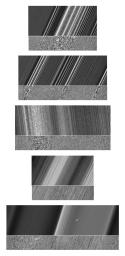
Figure 1
Click on image for larger versionImages here show the sunlit side of Saturn's rings. A strip along the bottom of each image has been filtered so that the textures are more visible. The filter consists of averaging and then subtracting out the major brightness variations across the scene. The images illustrate how textures in Saturn's rings differ, even in close proximity. Cassini had previously discovered that straw-like clumpy textures are visible in the troughs of the strongest density waves, such as the Janus 6:5 wave in the outer A ring (at top of Figure 1A). Images from Cassini's Ring Grazing Orbits show that similar clumpy textures are also visible in the troughs of medium-size density waves, such as the (left to right) Prometheus 26:25, 27:26 and 28:27 waves, also in the outer A ring (Figure 1B).
Strawlike texture is apparent in one band of the inner A ring but not surrounding regions (Figure 1C). Feathery texture is seen in some bands of the outer B ring, but not surrounding regions (Figure 1D). Figure 1E, which is an update of an image previously released as PIA21618, shows Plateau P1, where three textures are visible in close proximity to each other.
(See PIA03550 for a labeled diagram of the rings.)
The images in this montage were taken in visible light, using the Cassini spacecraft narrow-angle camera.
Figure 1A was taken at a distance of approximately 53,000 miles (85,000 kilometers) from the rings and at a sun-rings-spacecraft angle, or phase angle, of 56 degrees. Image scale is 1,700 feet (520 meters) per pixel.
Figure 1B was taken at a distance of approximately 48,000 miles (78,000 kilometers) from the rings and at a phase angle of 55 degrees. Image scale is 1,500 feet (470 meters) per pixel.
Figure 1C was taken at a distance of approximately 39,000 miles (63,000 kilometers) from the rings and at a phase angle of 39 degrees. Image scale is 1,300 feet (410 meters) per pixel.
Figure 1D was taken at a distance of approximately 62,000 miles (100,000 kilometers) from the rings and at a phase angle of 45 degrees. Image scale is 2,100 feet (630 meters) per pixel.
Figure 1E was taken at a distance of approximately 32,000 miles (52,000 kilometers) from the rings and at a phase angle of 80 degrees. Image scale is 1,100 feet (330 meters) per pixel.
The Cassini mission is a cooperative project of NASA, ESA (the European Space Agency) and the Italian Space Agency. The Jet Propulsion Laboratory, a division of Caltech in Pasadena, manages the mission for NASA's Science Mission Directorate in Washington. The Cassini orbiter and its two onboard cameras were designed, developed and assembled at JPL. The imaging operations center is based at the Space Science Institute in Boulder, Colorado.
The original Cassini ISS image ID numbers for these images are N1862643689, N1866983227, N1870075955, N1870076370 and N1875233884.
For more information about the Cassini-Huygens mission visit https://solarsystem.nasa.gov/cassini. The Cassini imaging team homepage is at http://ciclops.org.

 Planetary Data System
Planetary Data System













